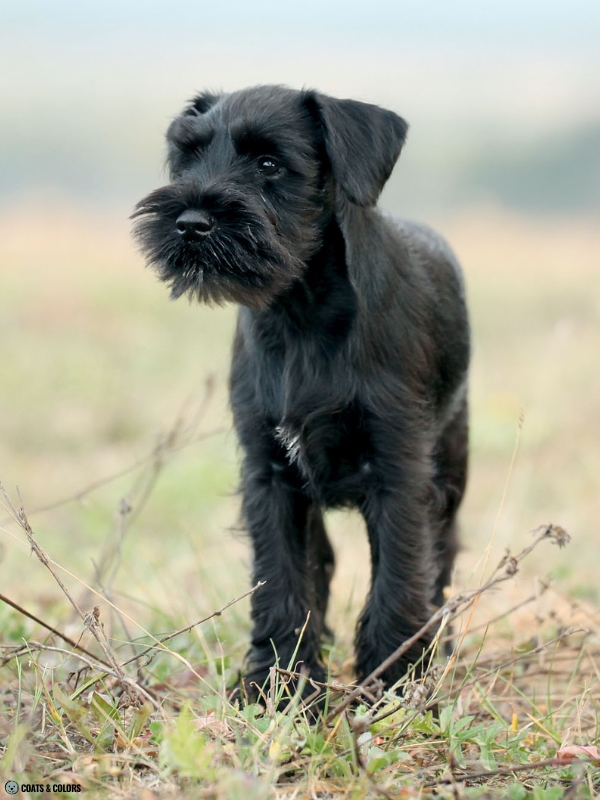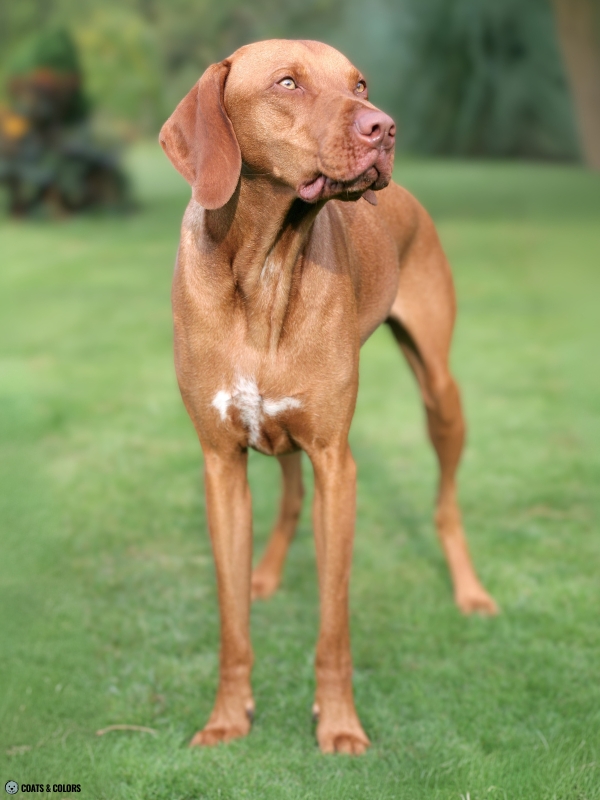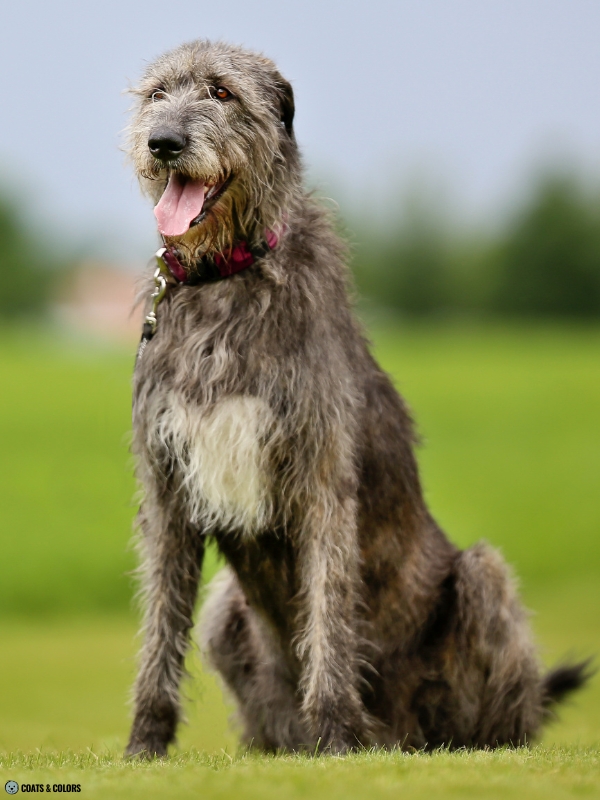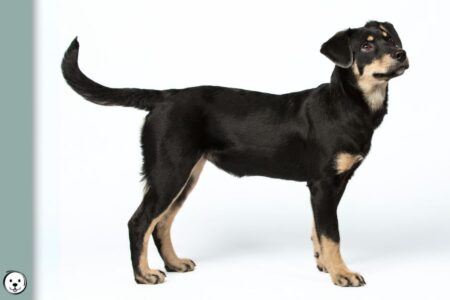Residual white describes any minor white pattern. Typical markings include a small white patch on the chest, white toes, or a tiny bit of white on the muzzle or forehead.
The white pattern is caused by incomplete pigmentation of the coat at birth. Small white markings like these may shrink or disappear as pigment continues to fill in.
Residual white can occur in any breed of dog as an otherwise harmless, random developmental delay with no genetic cause. In many cases, however, the presence of residual markings seems to be something that can be passed on to a certain extent, which is why many breeders try to avoid them.
What Is Residual White?
Residual white is just the common descriptive term used to describe small amounts of white on a dog.
The most common expression of residual white is a small white spot on the chest or minimal white on a dog’s paws. Some dogs might have minor muzzle white or a small white star on their forehead.






These markings are caused by an incomplete migration of pigment cells at birth.
Pigment continues to build up, though, and the white gradually recedes as the dog grows. Very small white spots are likely to disappear after a while or just shrink into a tiny patch of few white hairs.






However, some larger white markings such as a white sock or a white tie may not fully disappear. And residual white markings can be quite big if not kept in check by breeding away from them.
Residual markings can happen in any dog, even in breeds that are selected for a solid pattern. This is a naturally occurring phenomenon, it happens quite frequently and is no cause for concern.






Many breed standards even mention these markings and indicate in what size and where in the coat they are tolerated or not. For example, many solid breeds allow some smallish white spot on the chest.
Others are less forgiving with even the smallest white spot being a fault in conformation. This is why white markings are selected heavily against in many breeds.
Residual White Markings
A dog’s truly white hair is white because it lacks pigment. Residual white (any white pattern really) is caused by a developmental issue, something that disrupts the normal distribution of pigment.
During early development, pigment cell precursors migrate from the neural crest (a transitory collection of stem cells concentrated on the embryo’s topline) to populate other areas of the body[1].
Residual white happens when young pigment cells are unable to complete their journey from the neural crest to the dog’s periphery and extremities before birth.
That is basically why minor white markings typically appear on the midline and in the areas furthest away from the neural crest, such as the toes, forehead, or chest.

In many cases, pigment distribution is not quite finished when a dog is born. Just as hearing and vision continue to develop after birth, the pigment cells can also still add some pigment to the coat.
Minor residual white in very young puppies often becomes smaller or disappears completely. Some dogs born with a white bib may only keep a very, very small patch or thin stripe of white hairs.



What Causes Minor White?
The well-established white spotting patterns differ in the mechanism that disrupts pigmentation and the amount and placement of white they can produce in a dog’s coat.
Within specific patterns, there is always a certain amount of randomness as to where exactly white markings will appear. Additionally, some unknown modifiers may affect the actual amount of white.

There is still a lot to learn, but the overall most common traits in purebred dogs are piebald (S locus), whitehead (not testable), and Irish spotting (also not testable).
And there are likely a bunch of other white spotting traits that have not yet been identified.
In breeds where white patterns are common, some minimal white might actually just be a lesser expression the respective “typical” white pattern in this breed.
For example, in many cases, having only one copy of piebald (S/sP) or having a weaker dose of whatever causes Irish spotting or whitehead may cause just “some white”.








Some breeds have more “contained versions” of their white patterns than others due to selective breeding for moderate and as uniform white markings as possible. Lesser “doses” of these already restricted patterns can sometimes express with only small white markings such as a bib or white paws.




However, residual white can occur in the absence of other white patterns.
All breeds of dog can occasionally produce puppies with small white markings without any of the common white pattern traits involved. And the cause behind this type of residual white is unknown.
Interestingly, dogs with a recessive red pattern (e/e) seem to be somewhat predisposed. They have white markings on average slightly more often and express on average more white when they do.


There appear to be many different causes that can lead to a developmental delay or malfunction in the migration of pigment cells and thereby give some non-pigmented white areas.
The mechanism(s) that causes residual white may not even always have a genetic base.
Some puppies just happen to fill in pigment less successfully with pigment cells not quite fully migrating in utero due to otherwise harmless minor developmental issues.
For this reason, it is impossible to ever get rid of these markings entirely.
Dogs from any breed background can sometimes produce puppies born with small white markings despite generations of selection for a solid coat.






However, in some cases, minor white seems to be an inheritable trait after all. Breeders can very obviously select for a solid coat and against minimal white. And white markings happen more frequently in working breeds where breeders don’t care that much for show quality or coat color.
Breeding two dogs that showed residual white in their puppy coat might increase the chances to again produce puppies with some white on them. And whatever makes residual white happen can add up and cause puppies to have larger markings than their parents had.


But there is no single gene associated with residual white.
Breeders usually chose future breeding dogs that had no or just super minor white as puppies.
However, breeders don’t always know if one of their dogs had a mismarked puppy coat. As said earlier, these minimal white markings often disappear when a dog grows up. And oftentimes, you would never expect a dog to have had a white patch unless you have puppy pics or the breeder told you.
Also, white pattern traits can add up, e.g. dogs can be whitehead and piebald at the same time.
And extended white patterns can of course mask that such a dog also would have had some residual white. You just can’t see a white chest spot if a dog already has a parti pattern.
When breeding from white-patterned lines of dogs there is a chance that they not only pass on their expected white pattern trait (e.g. piebald or Irish spotting) but also some other non-testable stuff.
Fun fact: Some breeds like GSD with solid patterns may have unknowingly selected for ticking or roan since this can help fill in residual white markings and make them disappear or at least be less noticeable
Learn More
Links
[1] Brancalion, Haase, Wade (2022): Canine coat pigmentation genetics: a review. Anim Genet 53. https://doi.org/10.1111/age.13154

Hi! I’m Steffi. I am a biologist and a big time dog nerd. You are curious about coat color genetics? You’ve come to the right place! Read more.








1 thought on “Residual White”
Comments are closed.